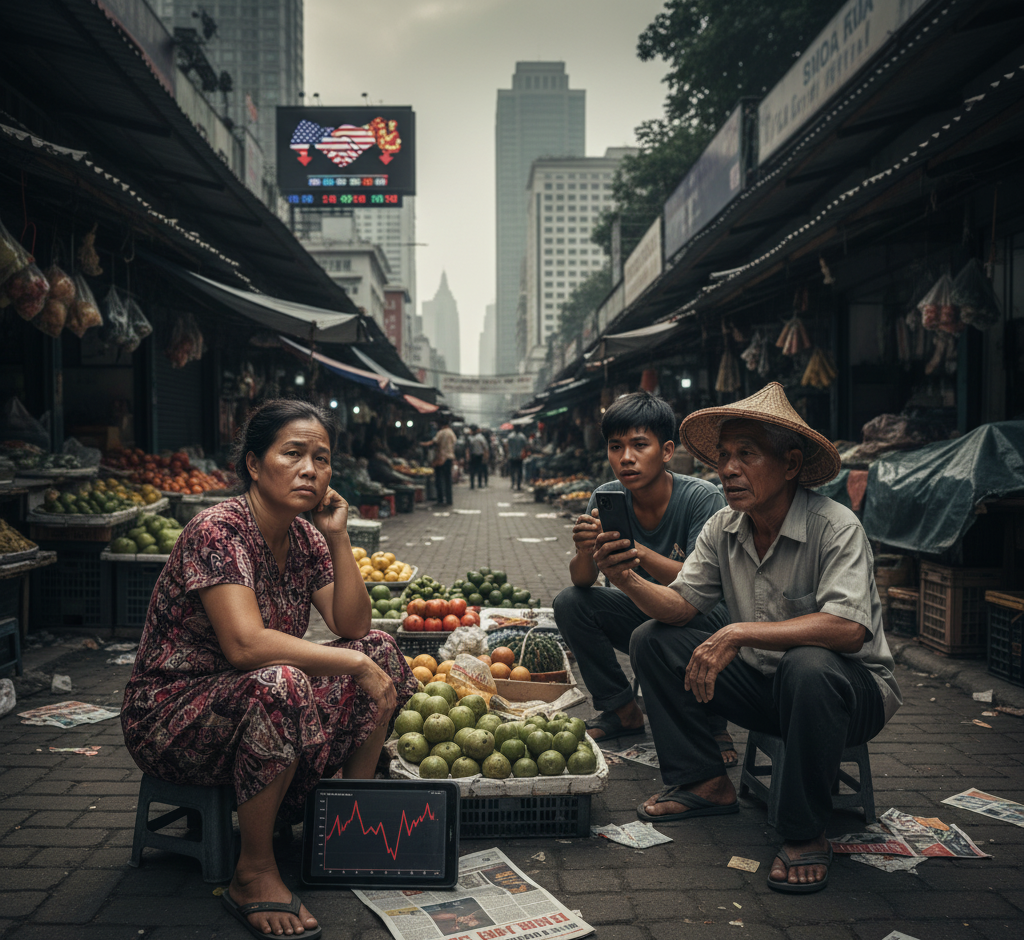
Introduction
There are tremors that start in one corner of the world and end up shaking the entire financial landscape. The renewed trade tensions between the United States and China have become one of those tremors — steady, relentless, and increasingly global. Each new tariff threat, each export restriction, each retaliatory statement between Washington and Beijing sends ripples through the stock exchanges of São Paulo, Mumbai, Johannesburg, and beyond.
It’s not the first time these two economic powers have collided, but the atmosphere feels heavier now. The pandemic changed trade routes; technology has turned into a battlefield; and a sense of fragility lingers across emerging economies already burdened by debt, inflation, and volatile currencies. The world’s two largest economies are no longer just rivals in commerce — they are shaping the temperature of global confidence.
A fragile balance under pressure
Every time the United States tightens its grip on Chinese imports or imposes restrictions on advanced chips, Beijing responds with measures of its own: curbing exports of rare minerals, hinting at currency adjustments, or targeting U.S. companies operating in China. The pattern is familiar, yet each cycle seems to hit harder.
The result is immediate in the markets. Chinese equities slide, American indexes sway, and the echo travels fast. Oil prices drop on fears of slowing demand; gold rises as investors seek safety; currencies of export-dependent nations lose ground. For traders and policymakers in emerging countries, the turbulence is more than background noise — it’s a direct shock to their already delicate equilibrium.
The new face of the trade war
What makes this phase different from the earlier disputes of the late 2010s is the depth of technological rivalry. This is no longer about soybeans or steel; it’s about microchips, clean energy, and data dominance. The U.S. wants to secure supply chains and limit China’s access to critical technologies. China, in turn, is pushing for self-reliance and regional influence through trade blocs like RCEP and its Belt and Road Initiative.
This tug-of-war affects everyone. Global supply chains are being redrawn. Multinational companies are moving production to Vietnam, Mexico, or India — a process analysts now call “friendshoring.” But the costs are real: disruption, inflation, and the erosion of predictability.
For investors, this means that geopolitical analysis has become as important as corporate earnings. Markets used to react to economic fundamentals; today, they react to diplomatic tone.
The silent victims: emerging economies
If history has a pattern, it is that the weakest absorb the strongest shocks. Countries in Latin America, Africa, and Southeast Asia — many of them dependent on exports to China or the U.S. — are now caught in the crossfire.
Take Brazil, for example. When China’s manufacturing slows due to tariff pressure, demand for iron ore and soybeans drops, and the Brazilian real weakens. In India, concerns about a slowdown in Chinese demand for regional goods lead to capital outflows and volatility in the rupee. In Africa, economies that rely on Chinese investment for infrastructure projects are seeing funds dry up or delayed.
Meanwhile, U.S. monetary policy amplifies the pain. Each time tensions rise, investors flee to the safety of the dollar, pushing emerging-market currencies down and forcing central banks to raise rates or burn reserves. For ordinary citizens, it translates into higher prices for imported goods and slower growth.
In a world still healing from pandemic disruptions, such instability can quickly turn into political unease. Markets may recover, but societies rarely forget the inflation that eats away at their wages.

How fear travels faster than trade
Financial markets are, at their core, networks of emotion. Confidence moves capital; fear freezes it. When Washington and Beijing trade threats, the reaction is almost instantaneous. A tariff on Chinese goods can depress investor sentiment from Buenos Aires to Bangkok within minutes.
This is how interdependence becomes vulnerability. The globalization that once promised efficiency has also created fragility — a world where a policy decision in Washington can unsettle a textile factory in Dhaka or a copper mine in Peru.
For emerging economies, diversification has become both a necessity and a challenge. They are learning to balance between the two giants, seeking new trade partners while avoiding taking sides in what is increasingly seen as a technological Cold War.
Between politics and economics
Behind the market numbers lies a deeper question: what are the U.S. and China really fighting for? Part of it is economic — dominance in industries that will define the century. But part of it is political — a struggle for global influence, legitimacy, and narrative control.
For Washington, being tough on China has become bipartisan currency. For Beijing, resisting U.S. pressure is a matter of national pride and political survival. Both nations speak the language of trade, but the meaning has become ideological.
The markets, however, don’t care about ideology. They care about stability. And right now, stability is in short supply.
The human cost of volatility
It’s easy to speak of trade wars in the abstract, but their impact is painfully tangible. When currencies fall, people lose purchasing power. When exports decline, factories close. When investors pull out, governments cut spending. In emerging nations, where social safety nets are thin, every economic tremor hits families directly — in food prices, in unemployment, in lost opportunity.
For many young professionals in these economies, the dream of progress feels once again hostage to global politics. A generation that grew up believing in globalization now sees it weaponized, turned into leverage rather than cooperation.
What can be done
The world is not without options. Diplomacy, though bruised, still works. Both powers have reasons to avoid a full-blown confrontation: slowing growth, domestic pressures, and the risk of global recession. Yet, trust has eroded. Rebuilding it will require new frameworks for trade, technology, and transparency — perhaps not a return to the old globalization, but the birth of a more resilient one.
Emerging economies, meanwhile, must strengthen their internal foundations: diversify exports, invest in regional trade, build technological independence. The era of relying on a single superpower’s demand is ending. Resilience, not alignment, will define survival.
Conclusion
The tension between the United States and China is not just shaking markets — it is reshaping the map of global economics. For investors, it’s a warning that the age of easy growth under stable globalization is gone. For emerging countries, it’s a reminder that their fortunes remain entangled in decisions made oceans away.
But crises often carry clarity. The world is learning, perhaps painfully, that economic power without cooperation leads to collective weakness. If the two giants continue to clash, the rest of the world will keep paying the price.
And yet, in every market dip and every diplomatic rift, there remains a chance — however fragile — for dialogue. Because the alternative, as the current turmoil shows, isn’t victory for one side. It’s exhaustion for all.






